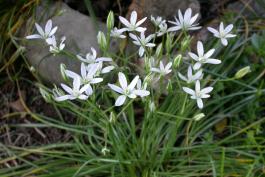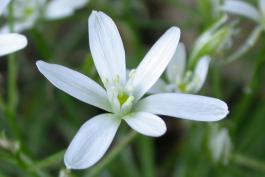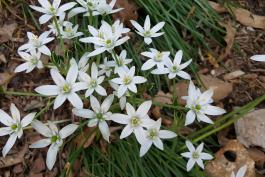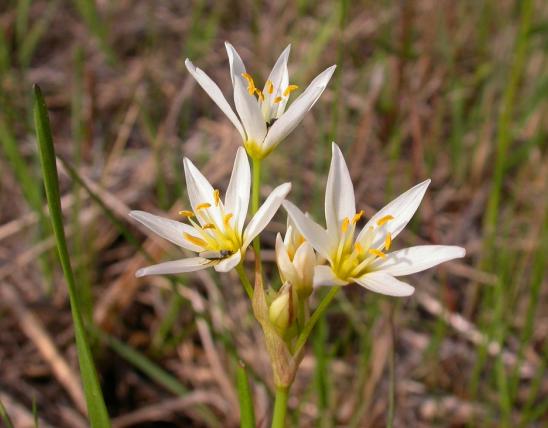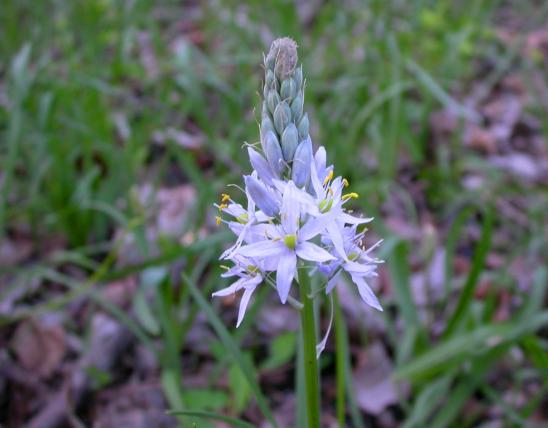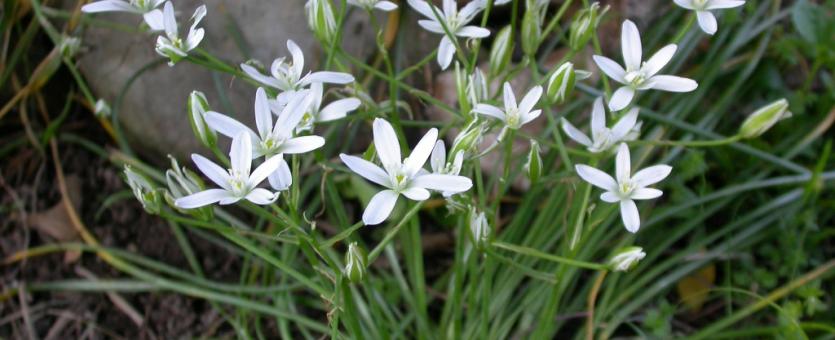
Star of Bethlehem's flowers are in clusters at the tips of stems to 1 foot tall. The 3 sepals and 3 petals (when they're so similar, they're collectively called tepals) form an attractive star, often 3-cornered, bright white on the upper surface, with green lines on the underside. Blooms April–June. The leaves are grasslike, succulent, very dark green, rolled inward with a white center vein. When the weather starts getting hot, the leaves turn yellow and start to wither away. Rootstock: bulbs, produced at an amazing rate.
Similar species: Crocuses, also native to Eurasia, also commonly appear in people's yards in early spring, and they, too, have grasslike leaves with a whitish stripe down the center. But star of Bethlehem's flowers are very different. Our native false garlic (Nothoscordum bivalve) is a bit similar, too, but it usually has yellowish flowers with pointier petals.
Height: to 1 foot.

Statewide.
Habitat and Conservation
Found in a variety of situations, including pastures, bottomland and upland forests, roadsides, suburban lawns, and disturbed areas. You might find it in the woods, persisting at old home sites. It is becoming relatively common on gravel bars and alluvial soils along many of our streams and rivers. A native of Eurasia and an aggressive colonizer, it forms dense clumps of bulbs.
Status
Also called star-of-Bethlehem (with hyphens), grass lily, and many other names across its global range.
This plant is weedy and potentially invasive and should not be planted in the Midwest.
Botanists have long been debating the relationships among the plants traditionally considered "lilies." In light of new molecular evidence, this plant has been placed in a family called the Asparagaceae, named for the asparagus genus. Some botanists have put it in the Hyacinthaceae, the hyacinth family. Formerly, it was considered to be a member of the lily family, the Liliaceae.
Human Connections
All parts of this plant are poisonous to both humans and to animals. Don't confuse this plant with wild onion.
Originally introduced to North America as an ornamental, it easily escapes cultivation, and it can become a lawn weed. Because it has invasive tendencies, it is best not to cultivate it.
If you have a potted spider plant (or airplane plant, Chlorophytum comosum), take at look at its flowers — they are very similar! It’s in the same family.
Ecosystem Connections
This plant was known to have escaped cultivation in Missouri as early as the 1830s. In our state, it apparently can’t reproduce by seed, but it does spread very prolifically by bulb division.
Also, water floats the bulbs in streams, so they easily become established along waterways.
People also accidentally transplant them when they move soil.
Apparently, few Missouri animals (whether vertebrates or invertebrates) seem to eat this toxic plant, meaning that it contributes little to our native ecosystems.




